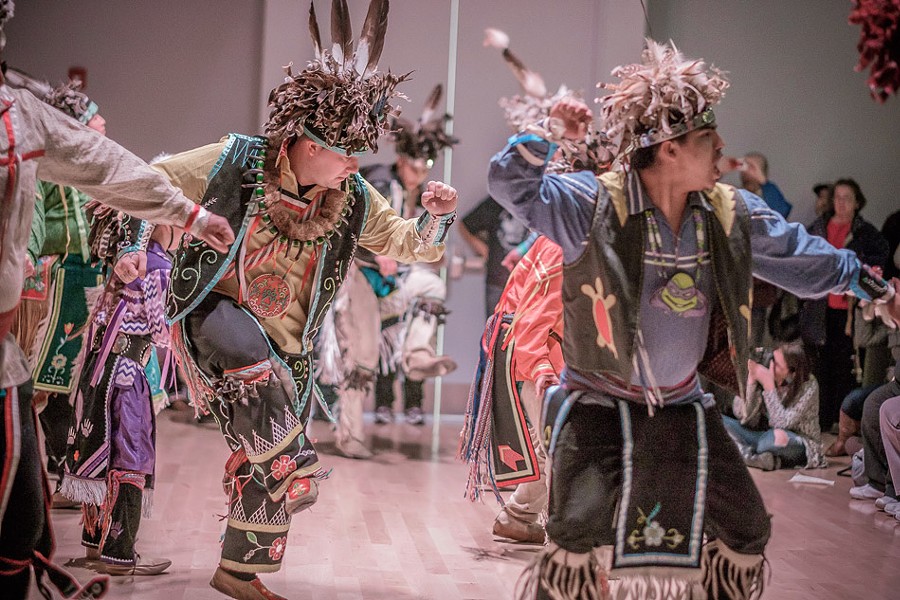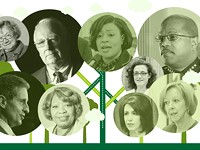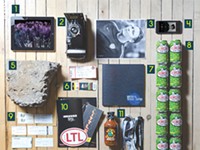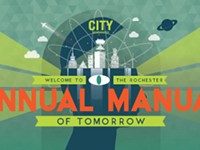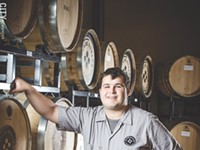Rochester performance groups carry traditional art forms into the future
The rich cultural diversity of Rochester's arts community shows in its various festivals and performance groups. Individuals who have landed in Rochester from afar as well as this region's Native Americans have sustained their culture's traditional performance arts, imbuing them with a timeless quality and engaging wider audiences.
And in addition to dazzling us with entertaining displays, many of the groups' leaders are also teachers, thereby helping to ensure the traditions are firmly rooted in the next generation. We spoke to four local groups who are keeping their traditions alive through performance and music.
There are performance groups related to many cultures in Rochester. If there is one that sticks out to you, leave a comment below this article online at rochestercitynewspaper.com.
Mounafanyi Percussion and Dance Ensemble
Mounafanyi Percussion and Dance Ensemble is a Rochester-based Pan-African performance group, merging musicians and movers from Africa and the African diaspora.
Artistic Director and master djembe player Kerfala "Fana" Bangoura has performed all over the world, and has gained international acclaim for his energetic drumming. A native of Guinea, he was a long-time member of that country's prestigious performance groups Les Ballets Africains and Les Percussions de Guinée, and after a stay in Portland, Oregon, he relocated to Rochester in 2009 when he took a teaching position at the University of Rochester.
The ensemble of about 15 members performs in colorful, traditional African dress, and focuses mainly on dances from Guinea, but also includes works from other African nations. By weaving drumming sequences with spirited dance, group presents an exciting, stamina-demanding performance.
"Drumming and dancing are a profound part of who I am; they are what I was born to do," Bangoura says. His father was a drummer who performed in a group with his uncle, and "watching them drum, dance, and sing was my first inspiration as an artist."
Mounafanyi performed as part of the 2013 Fringe Festival, and travels around New York State to perform at different venues. "But we would like to go everywhere in the United States, and internationally, too," Bangoura says. In addition to being a cultural ambassador in the US, Bangoura leads study trips for people interested in traveling to Guinea to experience the country's vibrant music and dance culture firsthand.
"Our goal is to make sure the culture is still alive," Bangoura says. To this end, in addition to performing, he teaches weekly workshops at DancEncounters (215 Tremont Street), and at the Baobab Cultural Center (728 University Avenue).
"Awareness is a challenge," he says, but Baobab in particular "is trying hard to draw in the future generations."
Mounafanyi will perform on April 30 at the Warsaw High School auditorium. Learn more at fanamusic.com and facebook.com/mounafanyi.
Gamelan Sanjiwani
Eastman School of Music's Gamelan Sanjiwani is one of the school's Balinese gamelan orchestras, which are part of the school's ethnomusicology program.
"Gamelan is the generic word for ensemble, and means 'to hammer together,'" says Ellen Koskoff, ESM professor of ethnomusicology and the director of ethnomusicology programs. Gamelan has existed in Indonesian culture for at least a millennium, and there are more than 20 different types. The term gamelan can also mean the set of instruments used in the ensemble.
Sanjiwani is a gamelan gong kebyar, which is the most popular ensemble in Bali today. "It's a very loud and flashy ensemble," Koskoff says. "Some people see it as the musical way in which the Balinese got revved up to gain their independence from the Dutch," in the beginning of the 20th century, she says. Gamelan gong kebyar was the first ensemble in Bali that wasn't connected to a court or a ritual, and is associated with freedom and democracy.
A gamelan gong kebyar typically has 25 to 30 participants, and is characterized by layers of sharp, colder chimes over warmly resonant tones, and rapid shifts in tempo. The ensemble is made up of different percussion instruments that fall into a few main groups: bronze keys called gangsa that are struck with a mallet and dampened with the player's fingers; kettle gongs called reyongs; drums called kendangs; and vertically suspended gongs that are struck to mark the beginning of each cycle.
The gamelan (the instrument set) "that we use now is owned by our teacher, I Nyoman Suadin, who is from Bali," Koskkoff says. Nyoman lives in Washington, D.C., but comes to Rochester every week to teach at Eastman.
At Eastman, as in Bali, the gamelan is learned through the aural tradition without notation. Anyone who wants can join the ensemble, with no musical experience required.
The ensemble is made up primarily of undergrads and students, but participating community members "are pretty much the backbone, because they don't graduate and leave," Koskoff says.
The group performs annually during the World Music Series at ESM in April, and as part of another World Music Series during the holidays. "We also often have little informal things that go on at Eastman in the gamelan room," Koskoff says.
Gamelan Sanjiwani is not geared toward preserving Balinese musical traditions — which are alive and well — but instead toward educating the students about world music, and forming a solid community, Koskoff says.
"There are no soloists," she says. "It's not a hierarchic thing, the way a Western orchestra is. Everyone is needed. I've lived in Bali, and I've seen this in action: when people stumble, somebody stops and helps them.
"Gamelan is a way of participating in social life. It's a way of doing dharma. The Balinese are mostly Hindu, so they see playing in a gamelan as your work, as a thing you should do to be a good citizen."
To learn more, visit esm.rochester.edu.
Bharata School of Indian Dance and Music
When Parvatha Chidambaram moved from India to Rochester in 1998, she brought an essential part of her culture with her. Chidambaram has practiced South Indian classical dance, Bharatanatyam, since she was 7 years old, and has performed all over India.
In 1999, she founded Bharata School of Indian Dance and Music in Pittsford. There, she teaches Bharatanatyam as well as Carnatic music. This classical music has an emphasis on the voice and is typically accompanied by a stringed instrument called the tambura and a percussive instrument called the mridangam.
"These art forms date back to almost 2,000 years of tradition," and they necessitate a deep understanding of the culture behind them, Chidambaram says. "I try to expose my students to history and theory, as well as the practical, so that they have a wholesome outlook on the art form."
Modern Bharatanatyam is the descendent of ancient court and temple dance. It was traditionally performed by the devadasis — woman who were dedicated to god — as part of a ritual in the temples, Chidambaram says. "So the stories and the mythology involved in these dance forms are based on the different deities of the Hindu religion."
Dancers of Bharatanatyam are exquisitely poised, and captivate the audience with an elegant balance of alternating motion and poses. "Our entire body moves," she says. "Along with hand gestures that have specific meanings, there are specific eye movements and expressions" that characterize the dance.
By incorporating acoustic instruments like drums and guitars, the classical music gains a wider appeal to younger generations. Last year, the school's annual production was called "Signs," and focused on the Zodiac.
Chidambaram has also choreographed Indian dances to Tchaikovsky's "Romeo and Juliet," inspired by a move her own teacher tried 30 years ago. "She had taken an episode from one of our Hindu mythologies, Ramayana, and she had choreographed for one of the parts of that. So I have reworked that choreography, and we are presenting that" at the annual performance, which takes place on April 10 at Hochstein School of Music & Dance.
"It is important for us to pass it on to the next generation and for them to understand the value and authenticity of the art form," Chidambaram says. "But we also need to understand the importance of how to package it, and how to entice them to get involved."
Bharata has six students graduating this year. "It has been a slow process, but a steady growth," Chidambaram says. "Our main challenge is to be out there and expose this beautiful art form to other communities as well."
To learn more, visit bharataarts.com.
Allegany River Indian Dancers
"I was born and raised on the Allegany Reservation, and grew up learning song and dance from elders," says Bill Crouse, leader of the Allegany River Indian Dancers.
From age 8 or 9, Crouse would travel with the elders to perform, until the early 1980's, when he started his own group.
The Allegany River Indian Dancers is multigenerational, and made up from families from the reservation, including Crouse's own children and grandkids. "Sometimes when we're traveling, my mom will dance with us, and when she does, we have four generations of our family dancing together," he says.
The company travels all over the nation and throughout Canada, presenting Iroquois social dancing in museums, at colleges, and at festivals. The group performs dances called Dances of the Earth — these do not include ceremonial dances, which are restricted to rituals.
Performances usually start off with a Standing Quiver Dance, Crouse says. "It's like a stomp dance. In our history, it goes back to when the men were leaving to go to battle or to hunt. They would stand quivers of arrows in the center of the dance area, and dance around them, asking for a blessing. The men would start it, and then the ladies would join in, showing their support."
The songs and dances are ancient, Crouse says. "They go back to that time when we were still living in bark longhouses, and when we were still very much in that warrior lifestyle." In modern times, the Standing Quiver Dance serves to call everyone together at the beginning of a social gathering.
The Allegany River Indian Dancers also perform Hoop dances — in which dancers twirl and hold hoops in different formations — that Crouse learned in his teens from a Navajo friend. Many of the other dances, such as the Fish dance, or Corn dance, are named after food, and have overtones of giving thanks, Crouse says.
The youngest dancer, one of Crouse's grandkids, is two years old. "He's pretty serious," he says. "He goes out there, dances his little legs off, stops on time ... he's a little showboat."
Crouse says there is a tangible enthusiasm for tradition among the youth and that some of his older children also do shows on their own. "The torch has already been handed off," he says.
See the Alleghany River Indian Dancers perform at the Imagine RIT festival on May 7. For more information, visit rit.edu/imagine.


